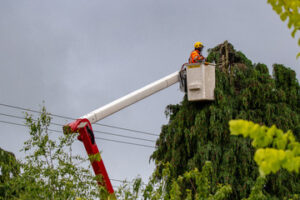SC Driveway Paving Charleston adds curb appeal and value to your home. Proper driveway paving is an investment that can last for several years with the right maintenance and care. The material you choose for your driveway should be based on the climate in your area and how you plan to use your driveway. Here are some options to consider:

When constructing a driveway, the sub-base is an important layer that distributes weight evenly and prevents pavers from shifting or sinking over time. It also helps with drainage and improves the strength of the base. The sub-base should be made of crushed stone or specific angular gravel and compacted down before the top layer is laid. It is common to see block paving driveways with sunken areas – this is often due to contractors skimping on the quantity of sub-base or using the wrong type of material.
The type of sub-base you choose depends on your priorities and budget. Some prefer natural materials like gravel or clay bricks, while others may want more modern options like resin-bound pavers. There is also a variety of eco-friendly materials that can be used for the base, including permeable concrete and grass paving. For example, the popular SuDS-compliant stone setts allow rainwater to pass through the surface rather than draining into the sewer network.
Some of these eco-friendly alternatives are more cost-effective than traditional concrete. For example, an absorbent stone paved driveway can be less than PS70/m2, including installation. Grass paving is another affordable option, but you should be prepared to regularly refill any cracks and seal the surface every two years.
If you’re looking for a more durable and long-lasting solution, concrete is the most common material for a sub-base. It can be sourced locally and is an environmentally friendly alternative to aggregate. However, it can be prone to cracking and heaving over time.
You might also consider recycled aggregates, which are a great choice for the base of your paved area. These are a combination of broken bricks and concrete, which have been crushed and can be cheaper than buying new aggregates. The best type of recycled aggregate is MOT Type 1 – it has been tested by the Ministry of Transport and is guaranteed to be strong enough for paving. Wolf Paving uses this product as part of the sub-base for all their paving projects. If you’re looking to upgrade your driveway with a more sustainable material, contact Wolf Paving today.
After the sub-base layer is constructed and compacted, the paving crew will lay the asphalt binder. The binder is a load-bearing layer of the driveway made of large aggregate mixed with oil. It is the foundation of the driveway and helps withstand traffic and weather for decades.
When laying the asphalt binder, it’s important to maintain a consistent level of thickness to ensure the strength of the pavement. The paving team will use heavy equipment designed for mixing and placing the asphalt to help achieve this.
Once the binder has been placed, the paving crew will install the top course. It is the surface that your guests and neighbors will see, and it’s also known as the wearing course or surface course. The topping is installed over the binder layer, using smaller aggregate mixed with a bitumen/asphalt mixture. This layer is much less textured than the binder course and is meant to be more attractive.
The most popular material for a top course is blacktop. It is because it is very affordable and extremely durable. However, if you are looking for something more environmentally friendly, there are other options. Porcelain, resin-bound, and gravel are all good choices. Each offers different benefits. For example, if durability is a priority, stone setts are an excellent choice as they are extremely strong and long-lasting. If you are looking for an aesthetic solution, resin bound is a great option as it comes in various colors and can be hand-trowelled onto a new or existing base.
A few methods are used to determine the asphalt binder content in HMA samples. Solvent extraction methods separate and remove the asphalt binder from the aggregate, and the before and after masses are compared to determine the asphalt content. Nuclear methods also measure the asphalt binder content using a thermal neutron gauge, which measures the number of hydrogen atoms in the sample. Since the hydrogen atoms in an asphalt binder are attracted to water, which is present in most instances, the number of hydrogen atoms is proportional to the amount of moisture in the sample.
The base layer of your driveway is the main supportive structure that asphalt sits on top of. It is made of free-draining gravel and sand that is compressed into a solid surface. The base layer absorbs the vehicle’s load and helps maintain a stable, frost-resistant consistency. This layer is important for a long-lasting, high-quality paved driveway.
If the sub-base is not properly constructed, a pavement surface will quickly wear out and require expensive repair. It can be avoided by following the paving construction recommendations and using the proper materials. The most common choice for the base is an unbound (plain) or bound aggregate. The quality of the aggregate particles and the bonding material, typically Portland cement or asphalt, determines the strength and durability of the base layer.
For residential paving projects, the ideal thickness for the base is 4 in. It is sufficient for pedestrian or light-wheeled traffic. For heavier vehicular applications, the consistency should be at least 6 in. It is especially important in northern climates with numerous freeze/thaw cycles.
Sometimes, a non-woven geotextile may separate the sub-base from the base course. It will help to prevent the base from deteriorating due to ground movement and improve the performance of the entire paved system.
After the base layer is placed and any soft areas are repaired, it is time for the asphalt binder to be added. This layer is an asphalt mixture with a higher percentage of large aggregate and fewer air voids than the mix used on roads. It is usually hot mixed and spread over the surface, then compacted by a static, steel-wheeled roller.
Properly installing the base and binder layers is crucial to achieving a durable, long-lasting pavement. Driveway paving is complex, and a slight blunder can have costly results. A professional paving contractor can consult the homeowner and create a project blueprint to ensure the best possible outcome.
When choosing a contractor to do your driveway paving, ensure they are licensed and insured. Getting proposals from multiple contractors and comparing the different types of mixes and constructions offered is also a good idea.
If you want your asphalt driveway to last, it needs to be built properly. That is why it’s best to leave the construction to a professional company that can use heavy equipment to get the job done quickly and efficiently, ensuring that your driveway will be strong enough for years of driving. Typically, new surface construction is done in two layers: a 2.5-inch thick binder and a 1.5-inch thick top layer. The binder provides strength, coats loose material, and plugs voids. The top layer adds durability and can be colored to match your home or complement the existing paving materials.
Pavement materials range from inexpensive, easy-to-install gravel to elegant paver bricks made of natural stone or fired clay, and then there’s the more common choice of asphalt. Asphalt is a good option for many people because it’s less expensive than concrete and requires much less maintenance.
A driveway, parking lot, or road that has deteriorated but maintains structural integrity can be resurfaced using an overlay or resurfacing process. It involves installing a new asphalt surface over the existing one, usually by milling (grinding) the existing pavement at its transition points to smooth rough spots.
Often, the base is the most critical part of a driveway paving project and can lead to failure if not installed correctly. There needs to be a more appropriate base design to prevent base failure, which can result in a finished product that is weaker, more porous, and susceptible to damage from traffic and weather conditions.
The base comprises crushed rock or an asphalt product that can be 3 to 4 inches thick on residential driveways and up to 18 inches on roads and parking lots. The base provides the load-bearing capacity of the finished asphalt and is installed over the subgrade. The correct style and base amount are determined by analyzing the soil type and condition at the project site.
Another form of paved driveways is tar-and-chip, a chip seal, or liquid asphalt. The process involves installing a gravel base, pouring hot liquid asphalt over it, and then coating it with a layer of loose stones rolled into the bitumen to create a finished, durable surface. This method is sometimes called permeable paving because it allows approximately 3 to 8 gallons of water per minute to pass through the loose stone, back into the ground naturally, and into the soil below.


